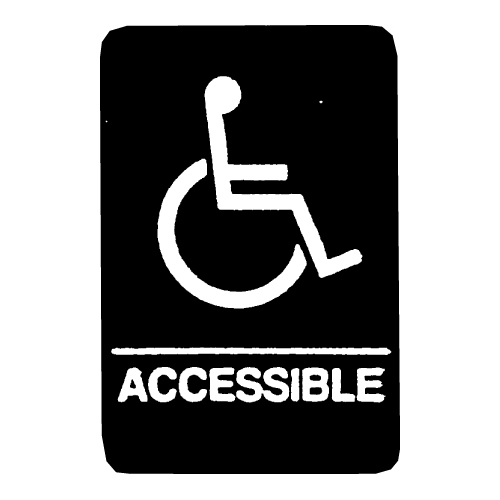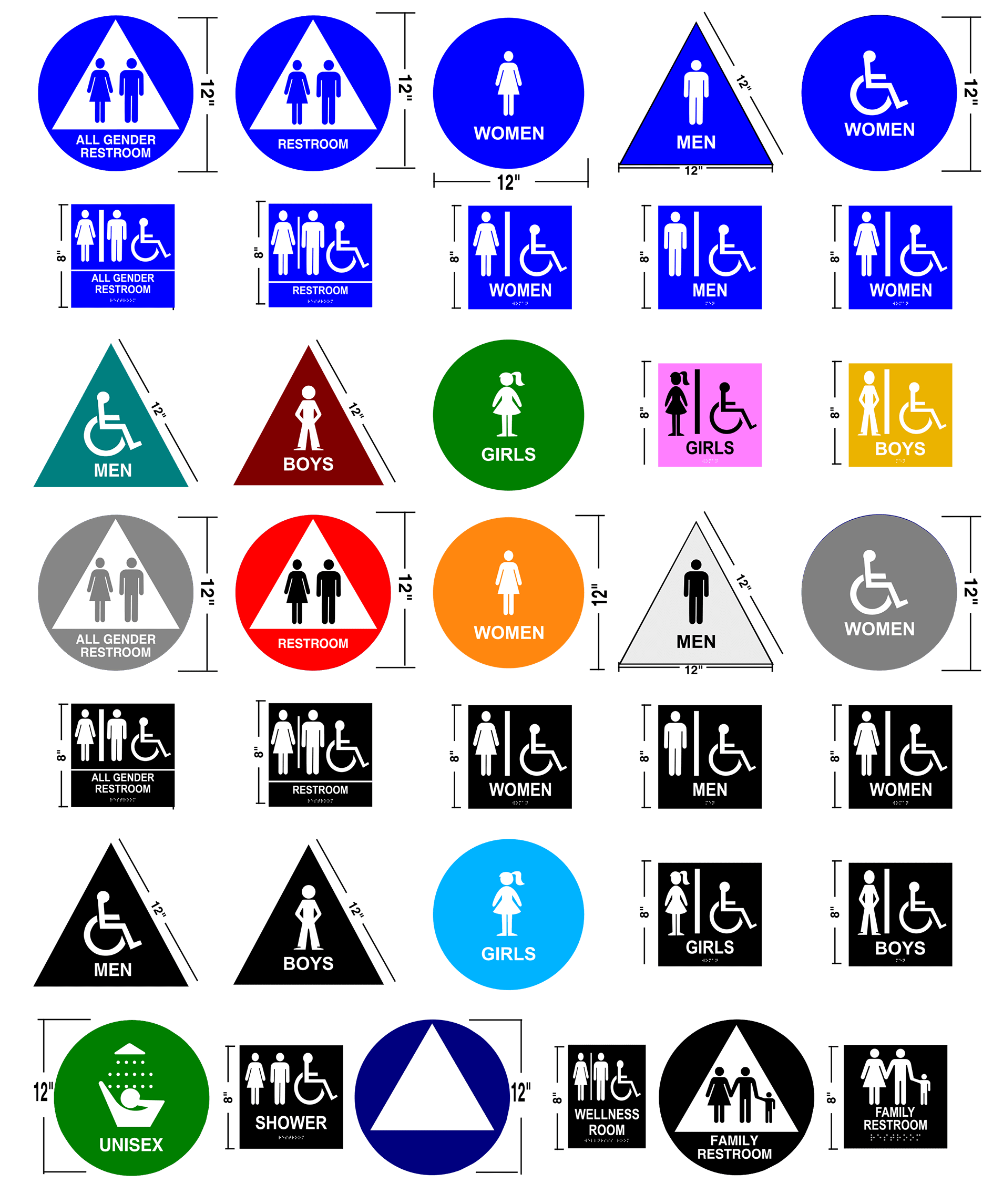Understanding the Regulations Behind ADA Signs
Understanding the Regulations Behind ADA Signs
Blog Article
Exploring the Key Features of ADA Indicators for Boosted Access
In the realm of availability, ADA signs serve as quiet yet effective allies, making sure that rooms are accessible and comprehensive for people with impairments. By incorporating Braille and responsive aspects, these indications damage obstacles for the visually impaired, while high-contrast shade schemes and understandable fonts provide to varied visual requirements.
Significance of ADA Conformity
Ensuring compliance with the Americans with Disabilities Act (ADA) is crucial for promoting inclusivity and equal gain access to in public rooms and workplaces. The ADA, enacted in 1990, mandates that all public facilities, employers, and transport solutions suit individuals with impairments, guaranteeing they enjoy the exact same legal rights and possibilities as others. Conformity with ADA requirements not just meets lawful commitments but likewise improves a company's online reputation by showing its dedication to variety and inclusivity.
One of the key facets of ADA conformity is the execution of accessible signage. ADA signs are developed to guarantee that people with handicaps can conveniently browse via structures and spaces. These signs must stick to specific guidelines regarding dimension, font style, color contrast, and positioning to assure presence and readability for all. Appropriately applied ADA signage helps eliminate obstacles that individuals with specials needs commonly experience, thus promoting their independence and self-confidence (ADA Signs).
Furthermore, adhering to ADA laws can alleviate the risk of potential penalties and legal consequences. Organizations that fail to abide by ADA standards might deal with legal actions or fines, which can be both economically burdensome and destructive to their public picture. Thus, ADA compliance is important to fostering an equitable atmosphere for every person.
Braille and Tactile Components
The unification of Braille and responsive elements into ADA signage symbolizes the principles of access and inclusivity. It is usually put underneath the equivalent message on signs to guarantee that individuals can access the information without aesthetic help.
Responsive elements prolong beyond Braille and include elevated icons and personalities. These parts are made to be noticeable by touch, enabling individuals to recognize area numbers, bathrooms, leaves, and various other essential areas. The ADA sets specific standards pertaining to the dimension, spacing, and placement of these responsive aspects to enhance readability and ensure uniformity throughout different environments.

High-Contrast Shade Systems
High-contrast color pattern play an essential role in boosting the presence and readability of ADA signs for individuals with aesthetic impairments. These systems are necessary as they optimize the difference in light reflectance in between text and history, ensuring that indicators are quickly discernible, even from a range. The Americans with Disabilities Act (ADA) mandates the use of details shade contrasts to fit those with limited vision, making it a critical aspect of conformity.
The efficacy of high-contrast shades hinges on their capacity to stand apart in numerous lighting problems, including dimly lit settings and areas with glare. Normally, dark text on a light history or light text on a dark background is used to accomplish optimum contrast. Black message on a yellow or white background offers a plain aesthetic difference that helps in fast acknowledgment and comprehension.

Legible Fonts and Text Dimension
When considering the design of ADA signs, the choice of clear font styles and suitable text dimension can not be overemphasized. The Americans with Disabilities Act (ADA) mandates that fonts must be sans-serif and not italic, oblique, manuscript, very decorative, or of unusual form.
The dimension of the message also plays a critical role in accessibility. According to ADA standards, the minimum text elevation must be 5/8 inch, and it should increase proportionally with seeing range. This is specifically crucial in public areas where signage needs to be read rapidly and accurately. Uniformity in text dimension adds to a cohesive visual experience, aiding people in navigating settings effectively.
Furthermore, spacing in between lines and letters is important to readability. Appropriate spacing prevents personalities from showing up crowded, improving readability. By adhering to these requirements, developers can substantially improve accessibility, making certain that signage offers its desired purpose for all people, despite their aesthetic abilities.
Reliable Placement Techniques
Strategic placement of ADA signs is vital for taking full advantage of accessibility Get the facts and ensuring compliance with legal requirements. Appropriately located indications direct individuals with handicaps effectively, promoting navigation in public spaces. Secret factors to consider consist more helpful hints of exposure, elevation, and distance. ADA standards stipulate that indications need to be placed at an elevation in between 48 to 60 inches from the ground to guarantee they are within the line of sight for both standing and seated people. This basic height range is vital for inclusivity, allowing mobility device users and people of differing elevations to gain access to info easily.
Furthermore, signs have to be put adjacent to the lock side of doors to allow easy recognition before access. Consistency in indicator placement throughout a center improves predictability, reducing complication and improving general user experience.

Verdict
ADA signs play a crucial duty in promoting availability by integrating attributes that resolve the demands of people with disabilities. Integrating Braille and responsive elements makes certain vital details comes to the aesthetically damaged, while high-contrast color pattern and clear sans-serif font styles improve presence throughout numerous lights conditions. Effective placement techniques, such as proper placing elevations and strategic places, additionally assist in navigating. These components jointly cultivate an inclusive setting, highlighting the value of ADA conformity in making sure find out equivalent accessibility for all.
In the realm of accessibility, ADA indicators offer as silent yet powerful allies, making certain that rooms are accessible and comprehensive for people with specials needs. The ADA, established in 1990, mandates that all public centers, companies, and transportation solutions fit individuals with disabilities, ensuring they appreciate the exact same legal rights and opportunities as others. ADA Signs. ADA indicators are created to guarantee that people with handicaps can conveniently browse through structures and areas. ADA standards stipulate that indicators ought to be placed at a height between 48 to 60 inches from the ground to ensure they are within the line of sight for both standing and seated people.ADA indications play a vital function in promoting accessibility by incorporating features that resolve the needs of people with disabilities
Report this page